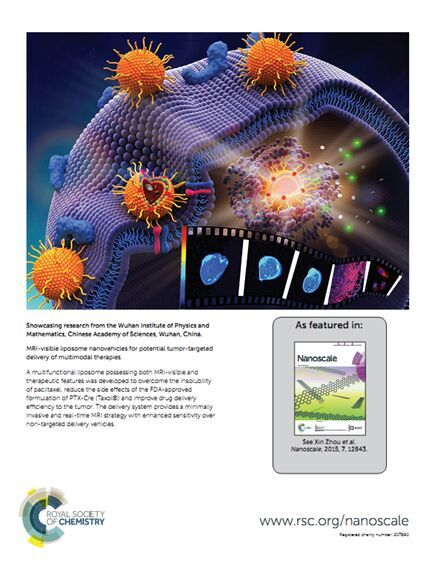

MRI-visible liposomal drug delivery
Real-time diagnosis and monitoring of disease development, and therapeutic responses to treatment, are possible by theranostic magnetic resonance imaging (MRI). Diagnosis and therapy are traditionally regarded as two separate issues in medical care. To achieve an optimal curative effect for many diseases, especially in cancer, they can be combined by liposomes. Recently, the lab of Prof. Xin Zhou at Wuhan Institute of Physics and Mathematics, CAS, developed a multimodal liposome for targeted delivery of anticancer drug paclitaxel and contrast agent Gd-DOTA, and the results have been published as a back cover article in a recent issue of the journal of Nanoscale.
(http://pubs.rsc.org/en/Content/ArticleLanding/2015/NR/C5NR02144H#!divAbstract)


Upper: The back cover of Nanoscale (Issue 7, 2015).
Lower: Schematic of the structure of the multifunctional liposome and the application of this liposome in theranostics.
The group designed and synthesized of a multifunctional liposome, which contains Gd-DOTA (an MRI probe), paclitaxel and c(RGDyk) (a targeted peptide).This nanoparticle overcame the insolubility of paclitaxel, reduced the side effects of FDA-approved formulation of PTX-Cre (Taxol®) and improved drug delivery efficiency to the tumor. The T1 relaxivity in tumor cells treated with the targeted liposome formulation was increased 16-fold when compared with the non-targeted group. In vivo, the tumors in mice were visualized using T1-weighted imaging after administration of the liposome. Also the tumor growth could be monitoredsafely after the treatment. These findings lay the foundation for further tumor inhibition study and application of this delivery vehicle in cancer therapy settings.
This research was supported by NSFC (81227902, 21305156).

Innovation Academy for Precision Measurement Science and Technology, CAS.
West No.30 Xiao Hong Shan, Wuhan 430071 China
Tel:+86-27-8719-8631 Fax:+86-27-8719-9291
Email:hanyeqing@wipm.ac.cn
鄂ICP备15017570号-1